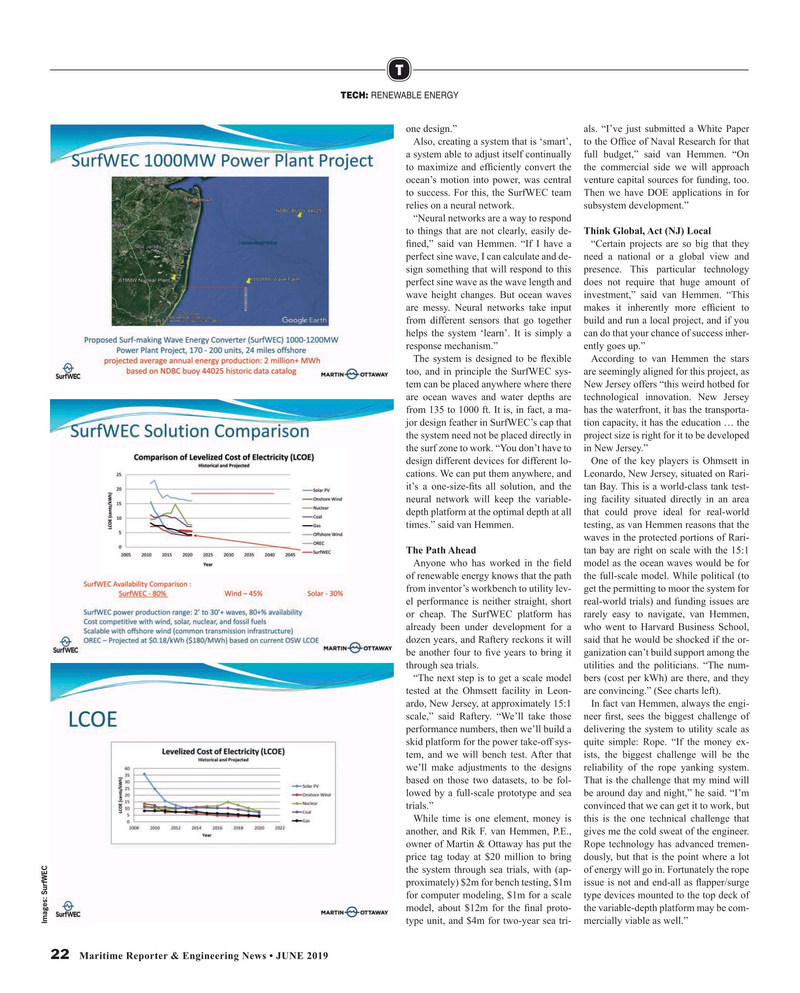
Page 22: of Maritime Reporter Magazine (June 2019)
80th Anniversary World Yearbook
Read this page in Pdf, Flash or Html5 edition of June 2019 Maritime Reporter Magazine
T
TECH: RENEWABLE ENERGY one design.” als. “I’ve just submitted a White Paper
Also, creating a system that is ‘smart’, to the Of? ce of Naval Research for that a system able to adjust itself continually full budget,” said van Hemmen. “On to maximize and ef? ciently convert the the commercial side we will approach ocean’s motion into power, was central venture capital sources for funding, too. to success. For this, the SurfWEC team Then we have DOE applications in for relies on a neural network. subsystem development.” “Neural networks are a way to respond to things that are not clearly, easily de- Think Global, Act (NJ) Local ? ned,” said van Hemmen. “If I have a “Certain projects are so big that they perfect sine wave, I can calculate and de- need a national or a global view and sign something that will respond to this presence. This particular technology perfect sine wave as the wave length and does not require that huge amount of wave height changes. But ocean waves investment,” said van Hemmen. “This are messy. Neural networks take input makes it inherently more ef? cient to from different sensors that go together build and run a local project, and if you helps the system ‘learn’. It is simply a can do that your chance of success inher- response mechanism.” ently goes up.”
The system is designed to be ? exible According to van Hemmen the stars too, and in principle the SurfWEC sys- are seemingly aligned for this project, as tem can be placed anywhere where there New Jersey offers “this weird hotbed for are ocean waves and water depths are technological innovation. New Jersey from 135 to 1000 ft. It is, in fact, a ma- has the waterfront, it has the transporta- jor design feather in SurfWEC’s cap that tion capacity, it has the education … the the system need not be placed directly in project size is right for it to be developed the surf zone to work. “You don’t have to in New Jersey.” design different devices for different lo- One of the key players is Ohmsett in cations. We can put them anywhere, and Leonardo, New Jersey, situated on Rari- it’s a one-size-? ts all solution, and the tan Bay. This is a world-class tank test- neural network will keep the variable- ing facility situated directly in an area depth platform at the optimal depth at all that could prove ideal for real-world times.” said van Hemmen. testing, as van Hemmen reasons that the waves in the protected portions of Rari-
The Path Ahead tan bay are right on scale with the 15:1
Anyone who has worked in the ? eld model as the ocean waves would be for of renewable energy knows that the path the full-scale model. While political (to from inventor’s workbench to utility lev- get the permitting to moor the system for el performance is neither straight, short real-world trials) and funding issues are or cheap. The SurfWEC platform has rarely easy to navigate, van Hemmen, already been under development for a who went to Harvard Business School, dozen years, and Raftery reckons it will said that he would be shocked if the or- be another four to ? ve years to bring it ganization can’t build support among the through sea trials. utilities and the politicians. “The num- “The next step is to get a scale model bers (cost per kWh) are there, and they tested at the Ohmsett facility in Leon- are convincing.” (See charts left).
ardo, New Jersey, at approximately 15:1 In fact van Hemmen, always the engi- scale,” said Raftery. “We’ll take those neer ? rst, sees the biggest challenge of performance numbers, then we’ll build a delivering the system to utility scale as skid platform for the power take-off sys- quite simple: Rope. “If the money ex- tem, and we will bench test. After that ists, the biggest challenge will be the we’ll make adjustments to the designs reliability of the rope yanking system. based on those two datasets, to be fol- That is the challenge that my mind will lowed by a full-scale prototype and sea be around day and night,” he said. “I’m trials.” convinced that we can get it to work, but
While time is one element, money is this is the one technical challenge that another, and Rik F. van Hemmen, P.E., gives me the cold sweat of the engineer. owner of Martin & Ottaway has put the Rope technology has advanced tremen- price tag today at $20 million to bring dously, but that is the point where a lot the system through sea trials, with (ap- of energy will go in. Fortunately the rope proximately) $2m for bench testing, $1m issue is not and end-all as ? apper/surge for computer modeling, $1m for a scale type devices mounted to the top deck of model, about $12m for the ? nal proto- the variable-depth platform may be com-
Images: SurfWEC type unit, and $4m for two-year sea tri- mercially viable as well.” 22 Maritime Reporter & Engineering News • JUNE 2019
MR #6 (18-25).indd 22 5/31/2019 9:39:18 AM

 21
21

 23
23
